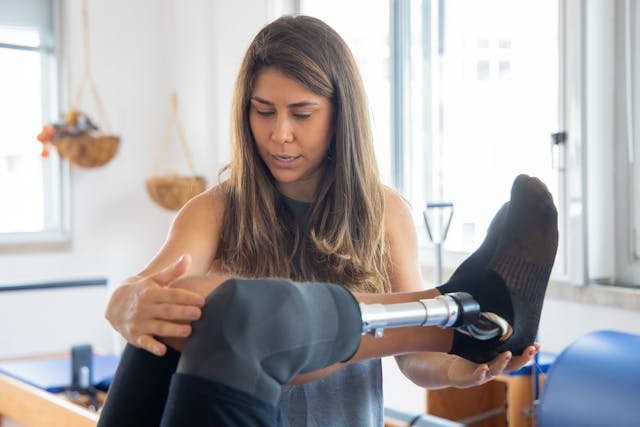Choosing your first prosthetic after an amputation is one of the most important decisions in your recovery journey. It’s not just about walking again—it’s about comfort, healing, confidence, and preparing your body for the next stage of mobility. The prosthetic you wear during this phase is called a post-operative or preparatory prosthesis, and it plays a key role in shaping how well and how quickly you adapt to your new way of moving.
At Robobionics, we guide every user through this step with care, patience, and deep understanding. Whether you’ve had a below-knee or above-knee amputation, this article will help you understand what matters when selecting the right post-operative prosthetic. With the right fit and support, your first steps can become the strongest foundation for a full, active life.
Understanding the Purpose of a Post-Operative Prosthetic
A post-operative prosthetic is often temporary, but its role is anything but small. It helps your body adjust after surgery and sets the stage for long-term prosthetic success.
Supporting the Healing Process
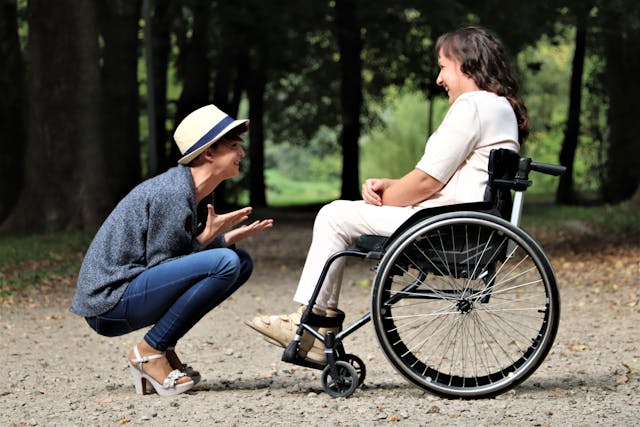
After surgery, your residual limb needs time to heal. Swelling must reduce, tissues need to settle, and the shape of the limb will change over the first few weeks or months. A post-operative prosthetic is designed to gently support your healing limb while still allowing some movement.
This device protects your residual limb from injury, helps shape it properly for a future custom socket, and offers mild compression to control swelling. It is not made for full activity yet—but it gets you moving safely, which is crucial for both physical and emotional recovery.
At Robobionics, we design our post-operative prosthetics with soft liners, breathable materials, and adjustable components. This allows comfort during this sensitive period while also preparing your body for more advanced mobility later on.
Encouraging Early Movement and Confidence
One of the key benefits of using a post-operative prosthesis is that it encourages early movement. Getting out of bed, standing, and even walking with support helps prevent stiffness, muscle loss, and balance issues. More importantly, it helps you feel like yourself again.
This early confidence boost makes a big difference. Users who begin moving early often feel more motivated, independent, and ready to continue rehabilitation. Even taking just a few steps each day can change how you view your recovery journey.
At Robobionics, we include basic mobility training during the post-operative phase. This helps users learn safe ways to move, turn, and stand without putting stress on their healing limb.
Preparing for the Definitive Prosthesis
The post-operative prosthesis is the stepping stone to your long-term or “definitive” prosthetic. It helps shape your limb, trains your body, and allows your rehab team to see how you move. All of this information is used later to create a prosthetic that matches your lifestyle and goals.
During this phase, you and your clinical team will learn what works best for you—how much support you need, what kind of alignment feels right, and which socket designs are most comfortable. That way, when it’s time to fit your final prosthetic, you’ll already be prepared.
Robobionics uses feedback from your early use to design better-fitting, more responsive prosthetics down the line. Your post-operative phase becomes the blueprint for long-term success.
Matching Your Prosthetic to Your Amputation Level
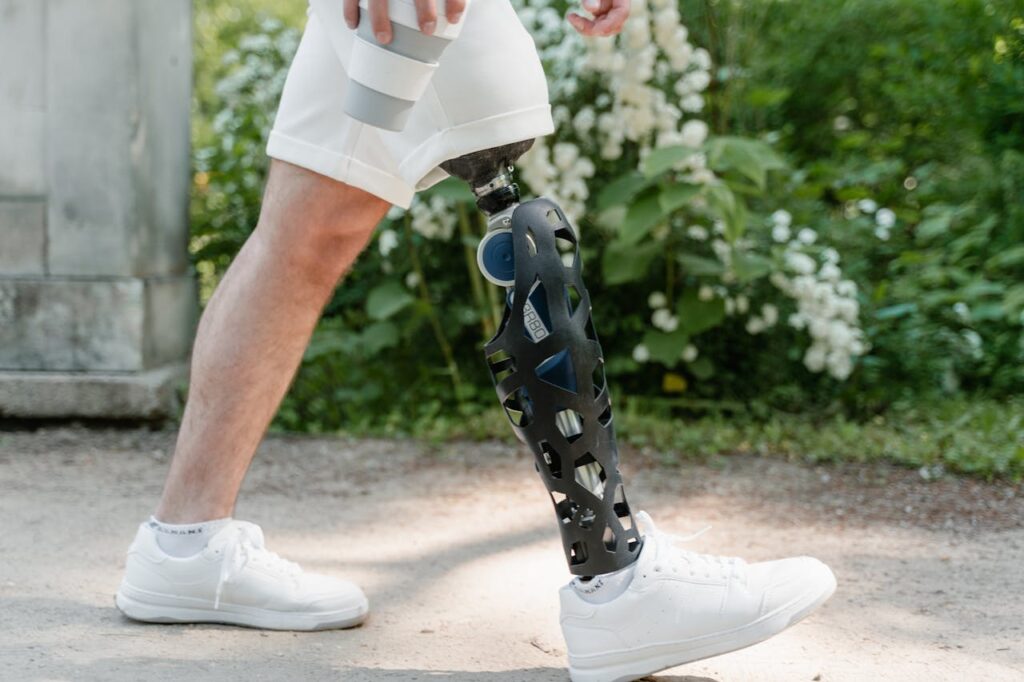
The type of prosthetic you need depends on where your amputation occurred. Transtibial (below-knee) and transfemoral (above-knee) users have different needs in the recovery phase, and your prosthetic must reflect those differences.
For Transtibial Users: Focus on Socket Comfort and Foot Control
For below-knee amputees, the socket is one of the most important parts of the prosthetic. During recovery, your limb will still be changing in size and shape. That’s why your first socket should be soft, adjustable, and easy to remove or refit.
Another key part is the prosthetic foot. At this stage, you don’t need a high-performance foot, but you do need one that offers balance, basic mobility, and some flexibility for walking practice. A foot that’s too rigid can make walking harder. A foot that’s too loose can cause discomfort.
Robobionics offers modular prosthetics for transtibial users that allow adjustments over time. Our team also includes pressure mapping and skin assessments to make sure your socket is as safe and smooth as possible.
For Transfemoral Users: Managing Knee Support and Hip Motion
Above-knee amputees face a different set of challenges. In addition to the socket and foot, the prosthetic must include a knee unit that helps with stability and swing control. During the post-operative phase, this knee should be simple and safe—focused more on balance than speed.
At this point, transfemoral users are learning to use their hip and core muscles to guide movement. The prosthesis should support this process by providing controlled motion, gradual bending, and resistance when standing.
Robobionics provides early-stage transfemoral prosthetics with adjustable knees that allow for walking practice at a safe pace. These devices build strength without putting stress on the user or their healing limb.
Adapting as the Limb Changes
No matter the level of amputation, your residual limb will shrink and reshape during the recovery phase. This is normal, but it also means your prosthetic fit will change. That’s why it’s important to choose a system that can be adjusted, re-lined, or replaced easily.
At Robobionics, we use modular designs that can grow with you during this stage. Our focus is on comfort, not perfection—because what works today may not work next month, and that’s okay.
Choosing the Right Socket Design and Suspension
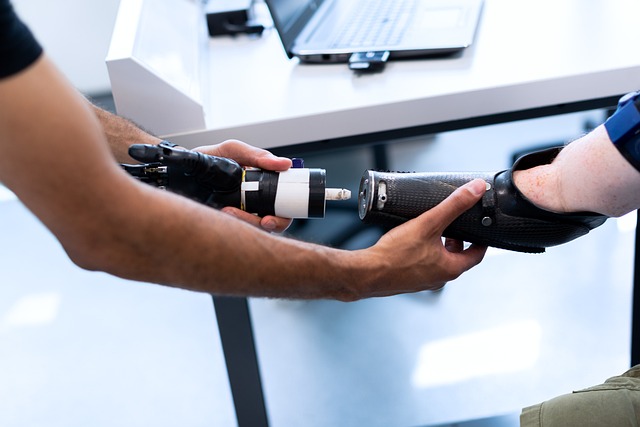
The socket is where your limb meets the prosthetic, and during the recovery phase, this connection must be gentle but secure. Choosing the right socket design and suspension system helps prevent pain, skin issues, and frustration.
Soft vs. Semi-Rigid Sockets
A soft socket is usually preferred during the early phase of recovery. It’s lined with cushioning materials that protect sensitive skin, reduce pressure points, and allow room for limb changes. It also makes the prosthetic easier to put on and remove.
A semi-rigid socket adds a bit more structure and may be introduced once healing has progressed. It offers better control and stability but still allows some flexibility. The choice between these depends on your healing progress and comfort level.
Robobionics carefully monitors your limb’s condition during follow-ups. If we see signs of irritation or poor fit, we adjust the socket or switch to a different material to keep you comfortable and supported.
Choosing the Right Suspension System
Suspension refers to how the prosthetic stays attached to your limb. During recovery, this must be secure enough to stay in place but gentle enough to avoid skin damage or discomfort. Common suspension types include suction, pin-lock, and sleeve systems.
Transtibial users often begin with a soft sleeve or pin-lock system. Transfemoral users may start with a basic suction system that holds the limb in place using gentle pressure. These systems are easy to use and offer stability without being too tight.
Robobionics matches each user with a suspension system that fits their activity level, limb shape, and skin condition. We also teach users how to put on and remove their prosthetic safely and how to check for signs of discomfort.
Adjustments and Follow-Ups
Because your body is still healing, you may need several adjustments during the recovery phase. This is normal and expected. Your prosthetist will monitor how your limb changes, how the socket fits, and how you feel while walking or standing.
At Robobionics, we schedule regular check-ins during this time. These visits allow us to make quick changes, update your fit, and keep your recovery moving forward without pain or pressure. We also welcome feedback at any time—because your comfort is our priority.
Physical Therapy and Your Post-Operative Prosthetic
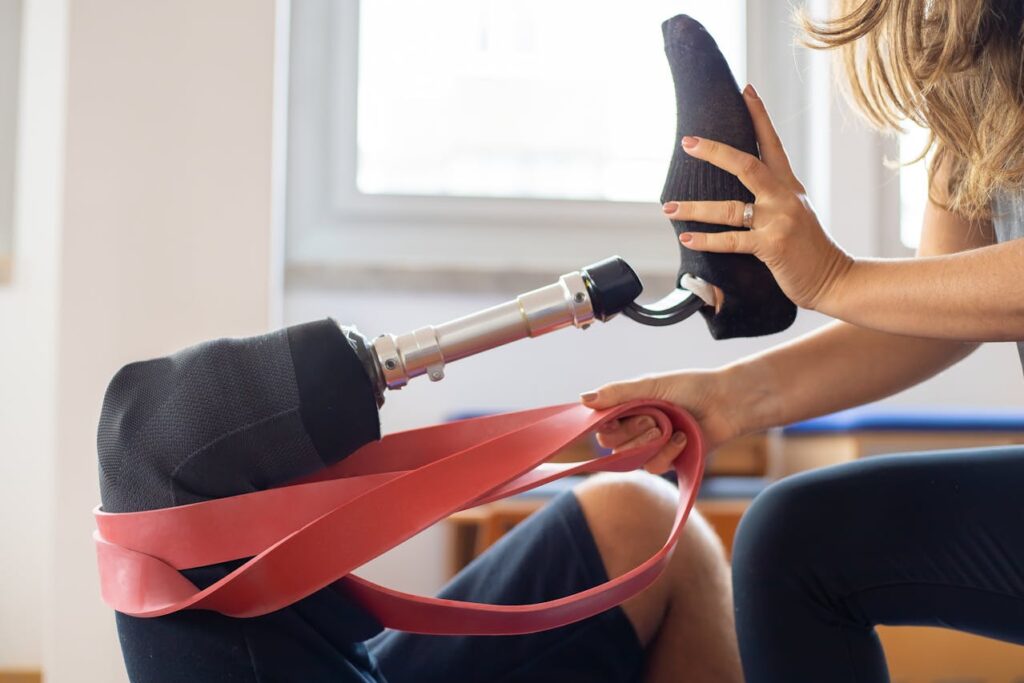
Wearing a post-operative prosthetic is just one part of recovery. To get the best results, it needs to go hand-in-hand with physical therapy. This is where your body starts learning how to move again with support from your new limb. The prosthetic is a tool, but therapy teaches you how to use it confidently and safely.
Starting with Gentle Movements
In the early weeks after amputation, your body is still adjusting. The focus of therapy during this time is not on walking long distances—it’s on gentle, steady movements. These small actions prepare your muscles, improve balance, and help you learn to trust your body again. For many users, just standing up with the prosthetic for a few minutes a day is a big milestone.
Your physical therapist will guide you through exercises that target your hips, core, and remaining leg muscles. For transtibial users, ankle stability and knee support are the main goals. For transfemoral users, learning to shift weight and build hip control is essential. The prosthetic you choose should match the pace of this early training, offering just enough support without being too complicated.
At Robobionics, we work closely with therapists and rehab teams to make sure the prosthetic supports your therapy—not makes it harder. Every part of the design is chosen to help you move naturally and gently at your own pace.
Learning New Patterns of Movement
Your body has its own rhythm of walking, standing, and balancing. After amputation, that rhythm changes. During therapy, you’ll begin learning a new pattern of movement that includes the prosthetic. This means adjusting how you step, how you keep your posture, and how you shift your weight with each motion.
It might feel strange at first. You may overthink every movement, or feel like your steps are uneven. This is where a good post-operative prosthetic makes a big difference. It should feel stable under your foot and move with your body instead of working against it. If the prosthetic feels stiff or awkward, your muscles will have to work harder, and therapy will feel more difficult.
Robobionics focuses on building prosthetics that respond to the body’s natural movement. Our post-operative devices are tested in real walking sessions to make sure they support—not interrupt—your progress. And as your strength grows, your prosthetic can be upgraded or adjusted to match your new ability.
Staying Consistent for Best Results
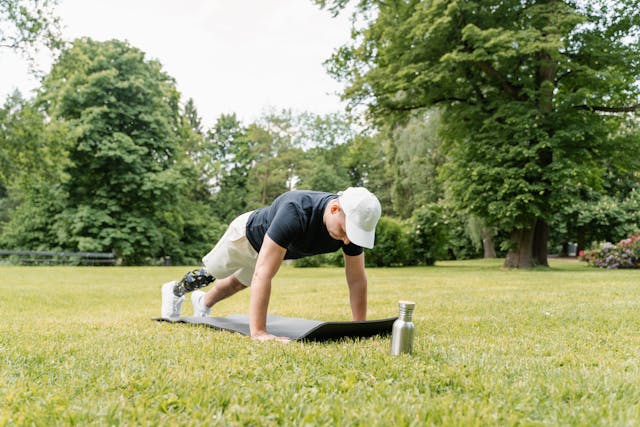
Therapy works best when it becomes a routine. Just like brushing your teeth, regular sessions and simple home exercises create long-term results. The more consistently you wear your prosthetic and follow your therapy plan, the faster your progress will feel. It’s not about doing a lot at once—it’s about doing a little every day.
Your prosthetic plays a huge role in keeping you motivated. If it fits well, feels light, and lets you move without pain, you’re more likely to use it daily. If it feels uncomfortable or unstable, it may cause you to stop using it, which can slow recovery and lower confidence.
At Robobionics, we keep in touch with your rehab team throughout your recovery. We track how your prosthetic is working for you and make changes as needed. This way, you stay supported—physically and emotionally—through every stage of therapy.
Planning Ahead: Transitioning to a Definitive Prosthesis
Once your residual limb has healed and you’ve gained basic mobility, the next phase of recovery begins—moving from your post-operative prosthetic to a definitive one. This transition is a big step forward, and planning it carefully ensures that you don’t lose the progress you’ve already made.
Knowing When You’re Ready
Most users stay in a post-operative prosthetic for a few weeks to a few months, depending on how their limb heals and how their body responds to early movement. One of the clearest signs that you’re ready for the next step is when your limb stops changing shape rapidly. Once the swelling has gone down and the limb has become more stable in size, a definitive socket can be created for long-term use.
Your rehab team will also look at your strength, balance, and gait. If you’re walking more smoothly, spending more time on your feet, and feeling confident in your movements, these are all strong signs that you’re ready to upgrade. You don’t need to wait until you feel perfect—progress is what matters.
At Robobionics, we monitor every user’s progress carefully. We conduct routine assessments to track limb volume, walking ability, and comfort levels. When the time is right, we begin the process of designing your definitive prosthetic with the knowledge we’ve gained from your early recovery.
Choosing Features That Match Your Lifestyle
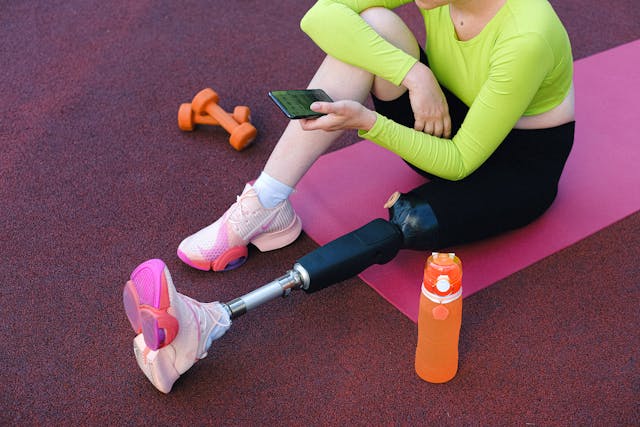
Your definitive prosthetic is not just a medical device—it’s something you’ll use every single day. That’s why it needs to match your life. Are you planning to return to work soon? Do you enjoy walking long distances? Will you be doing activities like driving, cooking, or gardening? All these factors help decide what features your prosthetic should include.
Transtibial users may want to switch from a simple post-op foot to an energy-return foot that feels more dynamic. Transfemoral users may look at knee joints with more options for movement control. Suspension systems, socket materials, and even aesthetics can all be tailored to suit your goals.
Robobionics takes everything you’ve learned during your post-operative phase and uses it to design a prosthetic that truly fits you. We offer demo sessions, activity-specific fittings, and trials that let you experience different components before making a decision. It’s a partnership—your input is at the center of the process.
Staying Connected for Long-Term Success
Even after you’ve moved on to your definitive prosthetic, regular follow-ups are important. Your body will keep changing as you grow stronger, return to daily routines, and build muscle. Staying connected with your prosthetic team ensures that small issues get addressed before they become bigger problems.
Your definitive prosthetic might need adjustments, relining, or new suspension parts as time goes on. That’s normal. What matters most is staying proactive and continuing to listen to your body. If you notice discomfort, skin irritation, or balance problems, don’t ignore them—these are signs your prosthetic might need tuning.
At Robobionics, we provide lifelong care. Our support doesn’t stop when your post-op phase ends. We offer repairs, upgrades, and personal support whenever you need it. And we’re always here to help you walk further, move better, and live more freely.
Conclusion
Choosing the right post-operative prosthetic is more than a medical decision—it’s the beginning of a new chapter in your life. This early device plays a powerful role in how your body heals, how your mind adapts, and how confident you feel taking your first steps after amputation. Whether you’re a transtibial or transfemoral user, the prosthetic you use during recovery shapes your journey in lasting ways.
A well-chosen post-operative prosthetic should support your healing limb, ease you into gentle movement, and prepare you for a successful transition to a long-term device. It should be comfortable, adjustable, and matched to your current needs—not rushed or complicated. With the right support, it becomes more than just a tool—it becomes your partner in recovery.
At Robobionics, we understand how important this early phase is. That’s why we focus on building prosthetics that are easy to wear, flexible to adapt, and designed to move with your body. We listen to your concerns, we follow your progress, and we guide you with care at every step of the way.
If you or your loved one is starting the recovery process after amputation, we’re here to help.



